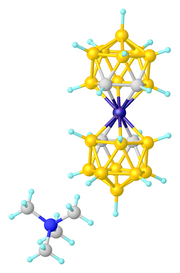Boranes

A borane is a compound with the formula BxHy or a related anion. Many such boranes are known. Most common are those with 1 to 12 boron atoms. Although they have few practical applications, the boranes exhibit structures and bonding that differs strongly from the patterns seen in hydrocarbons. Hybrids of boranes and hydrocarbons, the carboranes are also well developed.[1]
History
The development of the chemistry of boranes led to innovations in synthetic methods as well as structure and bonding. First, new synthetic techniques were required to handle diborane and many of its derivatives, which are both
The structure of diborane was correctly predicted in 1943 many years after its discovery.
The bonding of the clusters ushered in Polyhedral skeletal electron pair theory and Wade's rules, which can be used to predict the structures of boranes.[4] These rules were found to describe structures of many cluster compounds.
Interest in boranes increased during World War II due to the potential of
Chemical formula and naming conventions
Borane clusters are classified as follows, where n is the number of boron atoms in a single cluster:[1][6][7]
| Cluster type | Chemical formula | Example | Notes |
|---|---|---|---|
| hypercloso- | BnHn | Unstable; derivatives are known[8] | |
| closo- | [BnHn]2− | Caesium dodecaborate | |
| nido- | BnHn+4 | pentaborane(9) | |
| arachno- | BnHn+6 | pentaborane(11) | |
| hypho- | BnHn+8 | Only found in adducts |
The
-
iso-B18H22
-
Hexaborate(6)
[B6H6]2− -
Heptaborate(7)
[B7H7]2− -
Octaborate(8)
[B8H8]2− -
Nonaborate(9)
[B9H9]2− -
Decaborate(10)
[B10H10]2− -
Undecaborate(11)
[B11H11]2−
The naming of anions is illustrated by
- octahydridopentaborate, [B5H8]−
The hydrogen count is specified first followed by the boron count. The -ate suffix is applied with
Bonding in boranes
Boranes are nonclassically–bonded compounds, that is, there are not enough electrons to form 2-centre, 2-electron bonds between all pairs of adjacent atoms in the molecule. A description of the bonding in the larger boranes was formulated by William Lipscomb. It involved:
- 3-center 2-electron B-H-B hydrogen bridges
- 3-center 2-electron B-B-B bonds
- 2-center 2-electron bonds (in B-B, B-H and BH2)
Lipscomb's methodology has largely been superseded by a molecular orbital approach. This allows the concept of multi-centre bonding to be extended. For example, in the icosahedral ion [B12H12]2−, the totally symmetric (Ag symmetry) molecular orbital is equally distributed among all 12 boron atoms. Wade's rules provide a powerful method that can be used to rationalize the structures in terms of the number of atoms and the connectivity between them.
Multicluster boranes

Although relatively rare, several multi-cluster boranes have been characterized. For example, reaction of a borane cluster with B2H6 (as a source of BH3) can lead to the formation of a conjuncto-borane species in which borane cluster sub-units are joined by the sharing of boron atoms.[10]
- B6H10 + "BH3" → B7H11 + H2
- B7H11 + B6H10 → B13H19 + H2
Other conjuncto-boranes, where the sub-units are joined by a B-B bond, can be made by ultra violet irradiation of nido-boranes. Some B-B coupled conjuncto-boranes can be produced using PtBr2 as catalyst.[11]
Analogous to Wade's Rules, electron counting scheme has been developed to predict or rationalize multicluster boranes.
| Prefix | Meaning | Example |
|---|---|---|
| klado- | branched clusters | |
| conjuncto- | conjoined clusters | |
| megalo- | multiple conjoined clusters |
Reactivity of boranes
The lowest borane, BH3 exists only transiently,
The boron hydride clusters are so diverse that generalizations on their reactions are not possible.
Lewis acid/base behavior
Some function as electron donors owing to the relative basic character of the B−Hterminal groups. Boranes can function as
They can also act as
- B5H9 + 2 P(CH3)3 → B5H9·2P(CH3)3
Brønsted acid/base behavior
Some higher boranes, especially those with bridging hydrogen atoms, can be deprotonated with a strong base. An example:
- B5H9 + NaH → Na[B5H8] + H2
Acidity increases with the size of the borane, with B10H14 having a
Aufbau reactions

For the boron hydride chemist, one of the most important reactions is the building up process by which smaller boron hydride clusters add borane to give larger clusters. This approach also applies to the synthesis of metallaboranes,
Hydroboration
Reminiscent of the behavior of diborane and its adducts, higher boranes participate in hydroboration. When boron hydrides add an alkyne, the carbon becomes incorporated into the cluster, producing carboranes, e.g. C2B10H12.[17]
Applications
Diborane and its monomeric adducts
Boranes have a high specific energy of combustion compared to hydrocarbons, making them potentially attractive as fuels or igniters. Intense research was carried out in the 1950s into their use as jet fuel additives, but the effort did not lead to practical results.
Aspirational uses
Because 10B has a very high
- 10B + 1n → (11B*) → 4He + 7Li + γ (2.4 Mev)
See also
- Category:Boranes, containing all specific borane-compound articles
- Sara Rietti, nuclear chemist from Argentina
References
- ^ ISBN 978-0-08-037941-8. pp 151-195
- ^ Stock, Alfred (1933). The Hydrides of Boron and Silicon. New York: Cornell University Press.
- .
- S2CID 98202127.
- ISBN 0-471-11280-1.
- ISBN 0-471-19957-5
- ^ Lipscomb W. N. Boron Hydrides. Benjamin, New York (1963).
- PMID 11353472.
- PMID 20349936.
- ISBN 978-0-08-037941-8. p. 162
- S2CID 55817512.
- .
- ^ ISBN 978-0-08-037941-8.
- ^ temperature not stated
- ISBN 978-0-08-037941-8. p. 171
- .
- .
- PMID 25299942.
- ISBN 978-3-642-31333-2.








![Hexaborate(6) [B6H6]2−](http://upload.wikimedia.org/wikipedia/commons/thumb/9/9c/Hexaborate%286%29-dianion-from-xtal-3D-bs-17.png/105px-Hexaborate%286%29-dianion-from-xtal-3D-bs-17.png)
![Heptaborate(7) [B7H7]2−](http://upload.wikimedia.org/wikipedia/commons/thumb/0/01/Heptaborate%287%29-dianion-from-xtal-3D-bs-17.png/120px-Heptaborate%287%29-dianion-from-xtal-3D-bs-17.png)
![Octaborate(8) [B8H8]2−](http://upload.wikimedia.org/wikipedia/commons/thumb/3/33/Octaborate%288%29-dianion-from-xtal-3D-bs-17.png/120px-Octaborate%288%29-dianion-from-xtal-3D-bs-17.png)
![Nonaborate(9) [B9H9]2−](http://upload.wikimedia.org/wikipedia/commons/thumb/c/ca/Nonaborate%289%29-dianion-from-xtal-3D-bs-17.png/120px-Nonaborate%289%29-dianion-from-xtal-3D-bs-17.png)
![Decaborate(10) [B10H10]2−](http://upload.wikimedia.org/wikipedia/commons/thumb/e/e5/Decaborate%2810%29-dianion-from-xtal-3D-bs-17.png/95px-Decaborate%2810%29-dianion-from-xtal-3D-bs-17.png)
![Undecaborate(11) [B11H11]2−](http://upload.wikimedia.org/wikipedia/commons/thumb/a/ab/Closo-undecaborate%2811%29-dianion-from-xtal-3D-bs-17.png/120px-Closo-undecaborate%2811%29-dianion-from-xtal-3D-bs-17.png)
![Dodecaborate(12) [B12H12]2−](http://upload.wikimedia.org/wikipedia/commons/thumb/0/0e/Dodecaborate%2812%29-dianion-from-xtal-3D-bs-17.png/107px-Dodecaborate%2812%29-dianion-from-xtal-3D-bs-17.png)